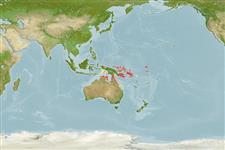>
Gobiiformes (Gobies) >
Gobiidae (Gobies) > Gobiinae
Etymology: Trimma: Greek, trimma, -atos = something crushed (Ref. 45335); meristum: Name from the Greek ‘meristos’, meaning divided; referring to the two dichotomous branches in the fifth pelvic-fin ray resulting in four terminal tips, distinct feature of this new species.
Environment: milieu / Klimaatzone / Diepte / distribution range
Ecologie
marien rifbewoner; diepte 0 - 7 m (Ref. 100726). Tropical; 1°S - 21°S, 14°E - 180°E (Ref. 100726)
Western Pacific: Australia (Great Barrier Reef), Papua New Guinea (Bismark Archipelago) and Fiji.
Grootte / Gewicht / Leeftijd
Maturiteit: Lm ? range ? - ? cm
Max length : 2.0 cm SL mannelijk / geslacht onbekend; (Ref. 119492)
Korte beschrijving
Determinatiesleutels | Morfologie | Morfometrie
Dorsale stekels (totaal) : 7; Dorsale zachte stralen (totaal) : 8; Anale stekels: 1; Anale zachte stralen: 7. This species is distinguished by the following characters: concave bony interorbital is less than half pupil-diameter in width; with a slight or no groove posterodorsal to the eye; scales in the midline of the predorsal 8-10; anal-fin rays 7; the fifth pelvic ray is branched twice dichotomously and subequal to the fourth in length, with a full basal membrane; the epaxial musculature reaches anteromedially to a point in line with the posterior margin of the pupil in adults; scale pockets on the head and body are strongly outlined by brown chromatophores (Ref. 100726).
Body shape (shape guide): fusiform / normal; Cross section: oval.
Species collected from jetty pilings, log debris, and concrete stairs at the water’s edge, at about 1-4 meters. It apparently have an affinity for sponge-encrusted surfaces, but the general area where it is observed is characterized by extensive silty mud substrata inhabited by a large number of burrowing gobies. It was not previously observed despite nearly 100 hours of scuba-diving because the collection site is immediately adjacent to shore at a busy shipyard where diving is usually banned during daylight hours. Most of the specimens were found on the inner side of a single pillar of the jetty, which was situated in total shade (Ref. 119492).
Levenscyclus en paargedrag
Maturiteit | Voortplanting | Paaien | Eieren | Fecunditeit | Larven
Winterbottom, R. and D.F. Hoese, 2015. A revision of the Australian species of Trimma (Actinopterygii, Gobiidae), with descriptions of six new species and redescriptions of twenty-three valid species. Zootaxa 3934(1):001-102. (Ref. 100726)
Status op de Rode Lijst van het IUCN (Ref. 130435: Version 2025-1)
Gevaar voor de mens
Harmless
Gebruik door de mens
Visserij: van geen belang
Tools
Speciale rapporten
Download XML
Internetbronnen
Estimates based on models
Fylogenetische diversiteitsindex (Ref.
82804): PD
50 = 0.5000 [Uniqueness, from 0.5 = low to 2.0 = high].
Bayesian length-weight: a=0.01023 (0.00477 - 0.02194), b=3.01 (2.83 - 3.19), in cm total length, based on LWR estimates for this (Sub)family-body shape (Ref.
93245).
Weerstandsvermogen (Ref.
120179): Hoog, minimale populatieverdubbelingstijd minder dan 15 maanden (Preliminary K or Fecundity.).
Fishing Vulnerability (Ref.
59153): Low vulnerability (10 of 100).
🛈
